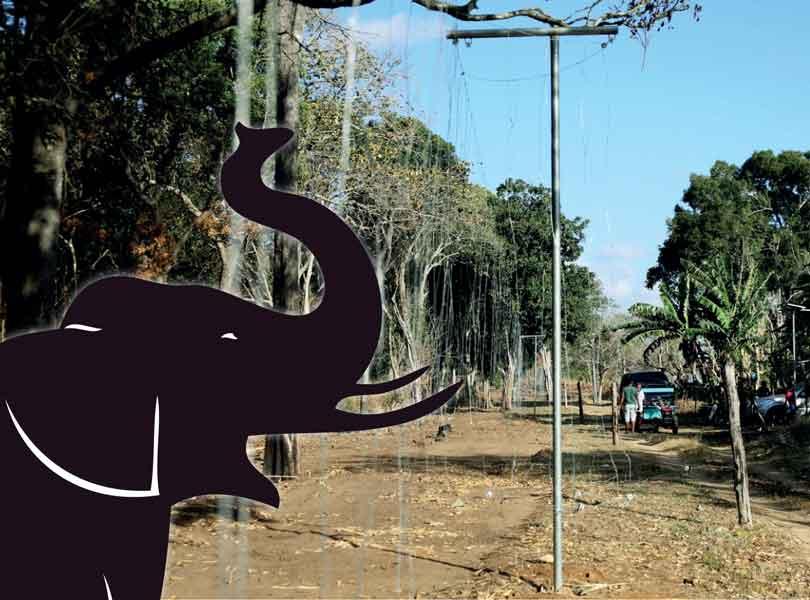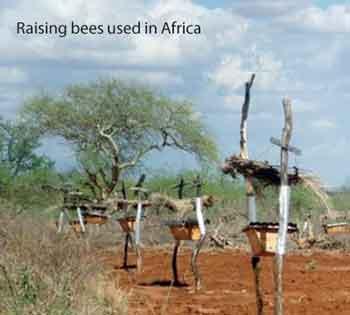Reply To:
Name - Reply Comment
Last Updated : 2024-04-26 22:10:00

 In almost every country with sizable populations of wildlife, there invariably exists animal-human conflicts. The pressure that is exerted on animal habitats due to growing human population is well understood even though no concrete national action has not yet taken in Sri Lanka to address this problem. Meanwhile, there is no cohesive population management strategies for animals who impart significant negative impacts on humans. A large population of wild elephants confined to reduced roaming ranges surrounded by villages invariably result in frequent conflicts.
In almost every country with sizable populations of wildlife, there invariably exists animal-human conflicts. The pressure that is exerted on animal habitats due to growing human population is well understood even though no concrete national action has not yet taken in Sri Lanka to address this problem. Meanwhile, there is no cohesive population management strategies for animals who impart significant negative impacts on humans. A large population of wild elephants confined to reduced roaming ranges surrounded by villages invariably result in frequent conflicts.
Recently, it was reported that the loss of forest cover in the country is happening at about 4 ha (10 acres) per day. For a country widely recognised as one of the richest in the world in biodiversity, this habitat loss is devastating in many ways. The Sri Lankan ‘magnificent trio’ consisting of ancient ruins, golden sandy beaches, and abundant wildlife (particularly, the elephants and leopards) are highly touted worldwide by global promoters of tourism. Meanwhile, the country goes on an unremitting rampage by systematically destroying these treasures year after year.
Elected officials have a moral as well as a national responsibility to stop these threats at once. However, many politicians heading relevant subject areas lack sufficient knowledge of the issues and it results in apathy and mismanagement of the resources. It is also noted with regret that in Sri Lanka, the voices of many educated and well-intended public servants are drowned out by the politically connected and promoted ‘mafia’ interest groups that have infiltrated almost every conceivable aspect of everyday life. It is widely known that many local environmental conservation NGOs are aligned with major political parties and work according to the wills of their political bosses rather than the betterment of the environment.
Among all animal-human conflicts, elephant-human encounter remains to be the most challenging. Several compounding reasons for this are the size and strength of the species, a large number of members in herds, wide-ranging roaming distances, need for large amounts of food etc.
For example, even in a country like South Africa, where many large wildlife parks are successfully managed over an exceptionally long period, encounters of humans and the so-called ‘Big Five’ species (elephant, lion, leopard, rhino, and African buffalo) are continually occurring despite much-dedicated effort to mitigate such incidents. For example, the world’s very first and perhaps the largest and most renowned safari park, Kruger National Park in South Africa (19,485 km² area with almost 900 km of paved roads. Compare the size of that with Sri Lanka with an area of 65,610 km²) that I also have visited, is struggling to save both humans and animals caught up in this struggle in which no one wins.
Among all the animal species, most resources are devoted to solving the elephant issue. Elephants are intelligent creatures that live long lives (60 years +), have an excellent memory, and have good ‘trouble-shooting’ skills as well as have no natural predators (except humans).
Without relying on the government to do everything for the masses, the citizens, especially the people who are directly affected must contribute to solving this problem. Absence of this mindset is a larger problem impairing progress on a national scale
One can easily see evidence of intelligent elephant behaviour by watching a few documentary films, especially the ones presented by the BBC, or by watching a few short YouTube videos (uploaded by many Sri Lankans in particular). Some prime examples show how elephants throw broken tree trunks on to the electric wires on fences to demolish those as well as carefully tugging the tops of the fence posts towards them while avoiding contact with the electric wires located just a few centimetres to and successfully break fences in mere seconds. The Sri Lankan electric fences seem to be designed with no regard to safeguarding against destruction by the same beasts that the fences are meant to keep out. The fences must be designed and built by people who are cleverer than the elephants themselves!
Sri Lanka’s elephant population has declined to about 7,500 according to the latest census, down from about 12,000 in the early 1900s. A record 405 elephants (5.7%) were killed by the humans in the country 2019, up from about 360 in 2018. A total of 121 people were killed by the elephants, up from 96 the year before, according to government data1. This high slaughtering rate of nearly 6% cannot be tolerated by any species. However, there is a high reproduction rate that may be partially compensating for the number killed. Sterilization of reproductive-age females (called ‘cows’) maybe becoming necessary unless other measures to mitigate the conflicts are not taken. Unfortunately, if the problem is left to continue, culling will become the only solution as has been the case in some African countries.
In relation to the situation in Sri Lanka with human-elephant conflict, one can say that the issue is being handled largely with lethargy and apathy. Sri Lanka Department of Wildlife Conservation and the authorities responsible for executing the laws of the land relating to the management of wildlife issues appear to be in a state of self-induced coma.
One does have to spend only a few minutes to prove this. Go to any computer or a smart-phone, access YouTube and search ‘Sri Lanka elephant encounters’. You will witness how wild elephants waiting by the roadside are being fed by people who travel in vehicles. Once the animals develop the taste for sweet and succulent fruit that is freely offered, it is no wonder that eating the traditional grass and leaf diet have become very boring to these elephants.
If there is a will, hundreds of the violators who feed wild elephants can be apprehended in a matter of a few hours. Even the public travelling in buses stop to give ‘treats’ to many wild elephants that frequent several roadways. Hundreds of YouTube videos posted by the perpetrators themselves can be viewed and the license plates of the offenders’ vehicles can be clearly seen. There are no records of any legal action taken against these hooligans who clearly do not understand the effect of their actions on animal health and behaviour. Apparently, there are roadside shacks selling bananas and melons solely for the sale to travellers in vehicles as ‘offerings’ for the begging elephants. It is a matter of time that the health of these animals be negatively affected due to the unnatural food they consume in large quantities.
This problem cannot be addressed from the air-conditioned offices in Colombo. First, we need proper monitoring of herd behaviour using a technique like drone surveillance. Then, there must be strategically stationed ‘rapid deployment’ units equipped with 4-wheel drive jeeps, all-terrain vehicles (ATVs), air guns, flares, and such. When a telephone message comes to this deployment office from a villager regarding a marauding elephant it could already be too late to manage the problem. That is why we need proper surveillance to anticipate where the problems could arise and take preemptive action.
Then comes the electric fence issue. Firstly, these must be designed by people who are smarter than elephants. Once built, fences must be continually monitored for confirming integrity. We have seen time and again that our culturally-induced attitude of ‘build and forget’ fails. It is inevitable that scheduled inspections must be an integral part of all systems. In problem areas, electric fence defences can be fortified with strategically dug trenches also.
On a side note, Canada still uses ‘watchtowers’ to spot forest fires during the summer season, even though it is being phased out in favour of drone surveillance. Perhaps, a similar watch tower method can be used by the villagers on a voluntary basis taking turns of a few hours at a time during periods of anticipated troubles. Without relying on the government to do everything for the masses, the citizens, especially the people who are directly affected must contribute to solving this problem. Absence of this mindset is a larger problem impairing progress on a national scale.
 We have a fundamental obligation to preserve the current elephant roaming ranges and take strong measures to prevent further human encroachment. Many tour companies in Europe and North America promote Sri Lanka as a premier destination for elephant watching. Part of the revenues generated by showcasing this national treasure to foreign tourists must be dedicated for the benefit of the elephants.
We have a fundamental obligation to preserve the current elephant roaming ranges and take strong measures to prevent further human encroachment. Many tour companies in Europe and North America promote Sri Lanka as a premier destination for elephant watching. Part of the revenues generated by showcasing this national treasure to foreign tourists must be dedicated for the benefit of the elephants.
While professionally qualified specialists in the relevant fields daydream about the ways to get a handle on resolving, or at least taking some control of a human-elephant conflict, here I intend to discuss two ‘low key’ and ‘low cost’ methods that could be utilised. It is appalling to see frequent news coverage of human death and property destruction caused by rampaging wild elephants as well as the killing of the beasts by the frustrated villagers. Hence, it is everyone’s responsibility to think deeply and find ways to mitigate this problem.
The two techniques I wish to discuss are;
1. Motion-activated propane cannons
2. Drone surveillance and elephant repelling using drones
Motion-activated propane cannons
 Motion-activated propane cannons are the hybrid of new and old technologies used in several countries to control many wildlife species. Propane cannons are made by fitting a simple, programmable ignition module to a household propane gas tank. The gas valve is opened by a programmable timer and an electronic igniter makes the leaking gas explode generating a sound like a gunshot.
Motion-activated propane cannons are the hybrid of new and old technologies used in several countries to control many wildlife species. Propane cannons are made by fitting a simple, programmable ignition module to a household propane gas tank. The gas valve is opened by a programmable timer and an electronic igniter makes the leaking gas explode generating a sound like a gunshot.
Propane cannons have been successfully used to scare birds away from airports and to prevent birds from landing on contaminated lakes in petroleum processing plants. In the USA, there are about 5,000 incidences of aeroplane and bird collisions per year, mostly near the airports. These collisions have been reduced by a great margin thanks to this technique. In the case of elephant deterrence, these cannons could be modified to be installed on heights (attached to trees etc.) so that the elephants are not able to destroy them.
Drone surveillance and repelling elephants using drones
The use of unmanned small aerial vehicles (drones) is common in Sri Lanka nowadays. Recently, those were even used for the surveillance of COVID-19 quarantine areas to monitor compliance. Many television media outlets also use drone-filming regularly. This technique has two major uses in wild elephant control.
Firstly, elephant movement can be observed from safe distances day or night (night vision heat-sensing cameras can even spot small animals in the jungle). Secondly, elephants are very scared of the sound of swarming bees. As mentioned in the study referenced below, a strong association of the sound of swarming bees and elephant rumbling in response to the danger of the presence of bees pose to the herds2.
 East Africa’s elephants face few threats in their savanna home, aside from humans and lions. But the behemoths are terrified of African bees and with good reason. An angry swarm can sting elephants around their eyes and inside their trunks and pierce the skin of young calves. Now, a new study shows that the pachyderms utter a distinctive rumble in response to the sound of bees, the first time an alarm call has been identified in elephants2.
East Africa’s elephants face few threats in their savanna home, aside from humans and lions. But the behemoths are terrified of African bees and with good reason. An angry swarm can sting elephants around their eyes and inside their trunks and pierce the skin of young calves. Now, a new study shows that the pachyderms utter a distinctive rumble in response to the sound of bees, the first time an alarm call has been identified in elephants2.
There are several wild-life documentary movies and short YouTube videos depicting how elephants run for their lives when they hear the drones humming and get closer and closer. It is hilarious to see how a tiny bee can scare such a smart and large animal and make them run away to hide under the thicket!
This technique has become phenomenally successful in several African game reserves, particularly in Serengeti Park3 in Tanzania (park area 14,750 km²).
(Here, I wish to site another abstract from a research paper published in the Oryx Journal 4)
“Protected areas across the range of the African Savannah elephant Loxodontaafricana are increasingly being surrounded and isolated by agriculture and human settlements. Conflicts between people and crop-raiding elephants regularly lead to direct reprisals and diminish community support for conservation. We report on field trials in northern Tanzania that employed a new, humane way for wildlife managers to move elephants away from conflict zones, from distances of > 100 m, thereby enhancing the safety of wildlife managers, farmers and elephants. We deployed 10 unmanned aerial vehicles (drones) piloted by five trained teams of wildlife managers in the Tarangire–Manyara and Serengeti ecosystems. Game Scouts deployed the drones opportunistically during crop-raiding events at the peak of the maize ripening period in 2015 and 2016. In 100% of trials (n = 51) elephants responded to the presence of a drone by departing rapidly from crop fields (n = 38) and settlements (n = 13). The cost of five teams responsible for 617 km ² in Tarangire–Manyara was estimated to be USD 15,520 for 1 year and all drones remained operational for the duration of the study. The initial success of this tool warrants further testing of the utility of small unmanned aerial vehicles as part of the toolbox for wildlife managers and communities dealing with high levels of conflict with wildlife”.
Other steps that can be taken
There are several other simple steps that could be taken to deter crop-raiding by the elephants. One such method, growing thorny trees such as orange around paddy fields, has been already used in Sri Lanka. Since orange trees grow very slowly, it is not considered a method giving quick results.
Two more effective methods used in Africa are to raise bees and to grow hot chillies around the perimeter of farming areas. Particularly bee culture can become a significant source of extra income for the farmers as well as improving crop production due to better pollination. However, the farmers must be provided with training and supply of provisions required. At the same time, farmers must be vigilant not to grow ‘sweet’ crops in areas prone to elephant crop-raiding. The current practice of growing sugar cane, corn, melon etc. adjacent to forest areas frequented by elephants is highly counterproductive.

Add comment
Comments will be edited (grammar, spelling and slang) and authorized at the discretion of Daily Mirror online. The website also has the right not to publish selected comments.
Reply To:
Name - Reply Comment
US authorities are currently reviewing the manifest of every cargo aboard MV
On March 26, a couple arriving from Thailand was arrested with 88 live animal
According to villagers from Naula-Moragolla out of 105 families 80 can afford
Is the situation in Sri Lanka so grim that locals harbour hope that they coul

5 hours ago
7 hours ago